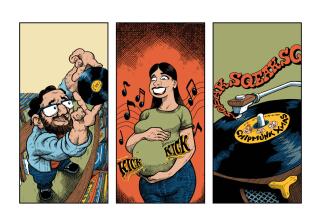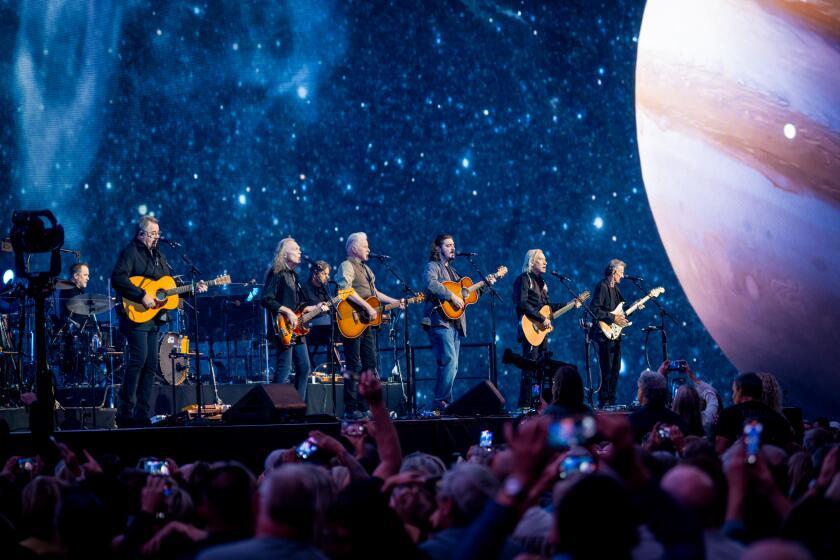RECORD FIRMS TRY AGAIN WITH CASSETTE SINGLES
The single is dead. Long live the single.
That, roughly paraphrased, is what many record industry observers are saying now that the 7-inch, 45 rpm vinyl single is on the wane. Coming along to supplement or maybe even replace it is the audiocassette single, which will carry the same music, for the same price ($1.98), as its vinyl counterpart.
The first major salvo in what looks to be a veritable blitz of cassette singles in coming months is Bryan Adamsâ âIn the Heat of the Night,â which came out this week. A&M; Records provided stores with a special countertop rack to display the single in its vinyl and cassette configurations, trumpeting the simultaneous release with the slogan: âFreedom of choice at last.â
For many consumers who want Adamsâ single, the choice wonât be hard to make. If theyâre typical of todayâs teen-agers, they may not even own a record player.
âYou see very few kids walking around with turntable boom boxes,â quipped Bob Reitman, vice president and general manager of A&M;âs marketing department.
Agreed David Steffen, A&M;âs vice president of sales: âWhat finally clicked was that this is the first generation that doesnât have a turntable. And singles are a teen and preteen item. Very seldom are singles an adult item, except for the country market.â
A&M; got a jump on its competitors by making plans for the Adams cassette single as early as last fall. But come June, the Adams cassette will have plenty of company.
Representatives from most major labels got together at Grammy time in February to discuss a unilateral June marketing rollout, as well as to agree on uniformity of packaging and promotion.
The result of that meeting is that tapes of about 40 or 50 of the current top hits should reach stores in about three months, all displayed in a large generic floor rack being designed for the industry by Arista Records.
The profit margin on singles is slim at best, and it is likely to remain that way. So why not let the format die a peaceful death and concentrate entirely on albums?
Itâs simple, in a roundabout way: Singles must exist because Top 40 radio stations depend heavily on those sales figures to know what songs to play--and that radio air play helps sell full-length albums, which is where the profit margin is more considerable.
This isnât the first time cassette singles have been given a try--I.R.S. Records had an unsuccessful go with the Go-Goâsâ âVacationâ in 1982, and Capitol tried several cassette maxi-singles (featuring longer versions of songs) in 1984 without much luck--but it is the first time the format has had a real shot, thanks to companies getting together for a concentrated, mutually beneficial push.
Why now? Why not five years ago?
âIt wasnât that dramatic a need five years ago,â said Jim Cawley, Arista vice president of sales. âThe shrinkage in 7-inch sales has been dramatic over the last five years. It wasnât uncommon then for a hit single to sell over a million copies. In this day and age, itâs almost unheard of.â
Also, said A&M;âs Reitman, âthe real hurdle for the cassette single was to be able to manufacture and sell one for the same price as a vinyl single.â
Michael OâBrien, vice president of business affairs at I.R.S., said, âThe only thing different between making a cassette single and a cassette album is the length of the tape inside the shell, and thatâs a very minimal part of the cost.â
Part of the solution for most companies will involve use of a slightly lower-quality tape for singles. But perhaps more important, the new breed of cassette singles will not come in the traditional clear âjewel boxesâ but in cheaper plastic shells.
Not only will that help enable companies to sell cassette singles at the same list price as vinyl singles, but the different shell will help prevent confusion with the full-length cassettes in the racks.
In case youâre wondering about the seriousness of the June rollout, this is not a test. This is a real emergency for the single, says Aristaâs Cawley, and the new format is here to stay whether itâs accepted immediately or not.
âThis rollout shouldnât be viewed as a make-or-break situation. We want to get maximum publicity and spread the word to kids in America that just because they donât own turntables anymore, that doesnât mean theyâre not part of the hit-making business.â
Retailers, for their part, are guardedly enthusiastic.
âI will say this: All the companies seem to be getting behind it, and theyâre trying to overcome the reservations we, the merchandisers, have,â said Larry King, assistant tape manager at Tower Records in West Hollywood, the cityâs most prominent retail outlet.
But King--who admits a strong âallegiance to vinylâ--notes that his store does a big trade in oldies singles and expresses concern over whether older tunes will be made available on tape if vinyl singles are eventually deleted entirely in favor of cassettes, as some predict.
âAre you going to put Elvis Presleyâs âBlue Suede Shoesâ on a cassette single?â King said. âSingles fulfill a need, and there are hundreds of them that you canât get on an album or cassette.â
A&M;âs Steffen figures that vinyl singles may remain as a âspecialty market,â but that cassettes will account for the âreal singles marketâ in from two to five years.
Beyond that, you can look forward to the compact disc single. Itâs expected to be at least a year or two before the price of a CD single can be brought down to a level consumers might accept--say, $4 or $5--but no one doubts it will happen.
In other words, even as the cassette single catches up with and perhaps gobbles up the vinyl single, it better be looking behind it lest it, too, become ancient history in the devouring jaws of the CD single.
More to Read
The biggest entertainment stories
Get our big stories about Hollywood, film, television, music, arts, culture and more right in your inbox as soon as they publish.
You may occasionally receive promotional content from the Los Angeles Times.










